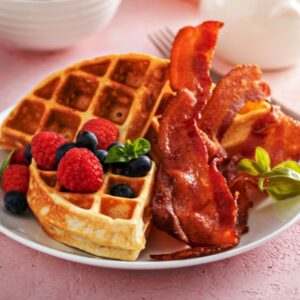 At restaurants and grocery stores throughout the country, you’ll encounter two types of waffles: a square or round traditional waffle and the Belgian waffle. While they look similar, Belgian waffles often have a fluffier texture and deeper pockets that hold onto syrup and other toppings. Learn more about the differences in origin, appearance and preparation.
At restaurants and grocery stores throughout the country, you’ll encounter two types of waffles: a square or round traditional waffle and the Belgian waffle. While they look similar, Belgian waffles often have a fluffier texture and deeper pockets that hold onto syrup and other toppings. Learn more about the differences in origin, appearance and preparation.
Waffle Origins
In concept, waffles date back to Ancient Greece. The Belgian waffle has been attributed to the Prince of Liege’s chef, who would prepare a thicker dessert covered in caramelized sugar.
Through the decades, Belgium’s waffle styles diversified, resulting in two distinct groups – the crunchier, bread-like Liege waffle and a softer, lighter Brussels variety made with a yeast-leavened batter. Today, the Liege waffle incorporates crystals of pearl sugar for more crunch and caramelization on the outside.
The Brussels waffle made its first appearance at the Brussels World Fair Expo in 1958 and entered North America four years later at the Century 21 Exposition in Seattle. These waffles topped with fruit became popular and contrasted against the flatter American variety. Since American consumers weren’t familiar with the Liege waffle, these expo offerings were simply dubbed “Belgian” waffles.
Meanwhile, the American waffle came across the Atlantic with Dutch settlers in the 17th century. By the 19th century, a patent was issued for a waffle iron to make the dish. During this time, it’s assumed that waffles were prepared in sweet and savory varieties akin to bread.
Waffle Appearance
Appearance stems from the waffle’s preparation. Oftentimes, the yeast-heavy Belgian waffle batter is intended to sit overnight. Doing so extends the leavening period, resulting in a fluffier and lighter waffle once you cook it in a waffle maker.
Waffle makers for the Belgian variety tend to have a larger, circular shape with deep, grid-like grooves. Once you add syrup or whipped cream on top, it’s more likely to stay within the waffle’s pockets, rather than slide off the surface. This design reflects the fact that they’re often eaten as street food in Belgium, bent like a taco and eaten with few – if any – toppings.
The thinner, rectangular-shaped American waffle can be similar to eating a stack of pancakes or French toast yet has a crispier texture.
Preparation and Cooking
In terms of preparation, both Belgian and traditional waffles share similar ingredients. However, you’ll notice some differences:
- Belgian waffles start with a yeasted batter, require a leavening agent and tend to include more butter, milk and sugar. If you try to make the Liege style, larger sugar granules are added for more crunch.
- Traditional or American waffles often substitute yeast with baking powder and do not sit overnight.
- Getting a fluffier texture may require you to whip egg whites before adding them to the batter.
- American waffles freeze well for reheating later.
In terms of cooking, waffle irons also vary slightly:
- Traditional American waffle makers have shallower grooves, although that’s beginning to change. Many waffle irons accommodate both types through a more consistent depth or interchangeable plates.
- Belgian waffle irons are thicker and wider with larger, deep square grooves covering the surface like a grid.
Craving a waffle? No matter the time of day, stop by Colony Diner to satisfy your sweet tooth with a variety of toppings! Review our menu before you sit down to dine or place an order for pickup today.






